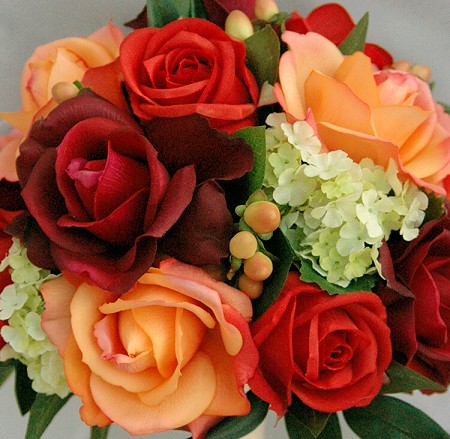|
Artificial flowers

Artificial flowers and imitations of natural flowers are sometimes made for scientific
purposes (the collection of glass flowers at Harvard University, for
example, which illustrates the flora of the United States), but more often as articles of decoration and
ornament.
Materials used in their manufacture have included painted linen and shavings of stained horn
in Egypt, gold and silver in ancient Rome, rice-paper in China, silkworm cocoons in
Italy, colored feathers in South America, and also wax and tinted shells. Modern techniques involve
carved or formed soap, nylon netting stretched over wire frames, ground
clay, and mass-produced injection plastic mouldings.
Early history
At the beginning of the 18th century the French, who originally learned the art from the
Italians, made great advances in the accuracy of their reproductions, and towards the end of
that century the Paris manufacturers enjoyed a world-wide reputation. About the same time
the art was introduced into England by French refugees, and soon afterwards it spread also
to America.
Production
The industry is now a highly specialized one with several different manufacturing
processes.
Cloth and paper flowers
Five main processes may be distinguished:
- The first step consists of putting the fabric in gelatine in order to stiffen
it.
- The second consists of cutting up the various fabrics and materials employed into shapes
suitable for forming the leaves, petals, etc.; this may be done with
scissors, but more often with stamps that can cut through a dozen or more thicknesses at one
blow.
- The veins of the leaves are next impressed by means of a die, and the petals are given their
natural rounded forms by goffering irons of various shapes.
- The next step is to assemble the petals and other parts of the flower, which is built up
from the center outwards;
- The fifth is to mount the flower on a stalk of brass or iron wire wrapped with suitably
colored material, and to add the leaves to complete the spray.
Paper and cloth flowers are also made with origami.
Soap Flowers
There are two methods:
- Carved: A bar with layered colored soap is mounted in a lathe, and circular grooves are
chiseled into it. The finished flower is symmetric and regular, but the flowers are not
identical and can be called handmade.
- Molded: An oil-less soap milled to a powder is mixed with water, and the paste is used as a
modelling material. Leaf and petal textures are stamped or rolled onto the
soap. This is an expensive, labour-intensive process.
Clay Flowers
Clay flowers are made of powdered clay mixed with water and coloring.
Plastic Flowers
Injection moulding is used for mass manufacture of plastic flowers. Plastic is injected into
a preformed metal die.
|
